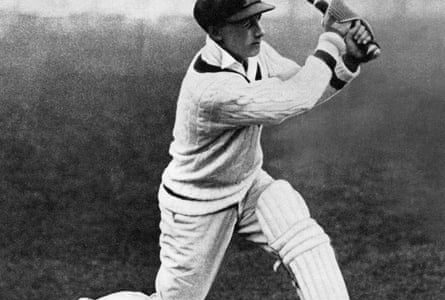
TThe most famous moment in the career of Australia’s greatest cricketer is his glorious failure. Don Bradman’s last innings duck in the fifth Ashes Test of 1948 at the Oval had little impact on the game. His team won by an innings and 149 runs and secured the series 4-0.
It’s a failure, but it reinforces the Bradman legend. A case of fallibility that makes his seemingly impossible career believable even now, a century later. He retired with an average of 100, except for rounding one decimal place. A total of 6,996 test runs, but still four too short.
The footage of the layoff is almost as well-known as Bradman’s career mark of 99.94. The English spinner Eric Hollies comes into the bowl, a hard hit against the playing Bradman, but it misses and the bails fall to the ground. The Australian captain turns and quickly walks away, looking skyward and seemingly smiling.
The importance of these seconds has grown. An unforgettable peculiarity in the astonishing consistency of the standard bearer. The match took place a week after Greg Chappell was born. Across his and subsequent generations, Bradman’s success story remains distinctly in a different class, an ambition that has helped drive Australia’s winning culture. And its double exclamation point, its memento mori, somehow makes it even more remarkable.
after newsletter advertising
But there is a moment in Bradman’s career that is far more important. A moment whose magnitude was celebrated in later decades by eyewitnesses rather than observers. When there was still something to gain and a lot to lose.
Before the boy from Bowral became a jack-of-all-trades, before he became untouchable, he was – briefly – human. By the mid-1930s, his influence was diluted by Bodyline tactics. He then went 13 first-class innings without a century, the longest such spell of his career. He returned to form in the 1934 Ashes, but soon after suffered complications from appendicitis and missed Australia’s 1935–36 tour of South Africa.
The Australian team, captained by the Chappell brothers’ grandfather Vic Richardson, performed well and won the Test series 4-0. Nevertheless, Bradman returned in the summer of 1936/37 as a selector and – for the first time – as captain for England’s Ashes tour.
The machinations entangled the man in the politics of the time. A controversial decision by Bradman and his fellow selectors to drop experienced bowler Clarrie Grimmett and give four players their debuts was therefore a gamble. And when the first two Tests resulted in back-to-back defeats, reports of “discord” filled the newspapers. Dissent, against the Don!
A full MCG in the third Test resulted in Bradman scoring 13 in the first innings. It rained late on the first day and when play resumed there was an avalanche of wickets: 15 for just under 130 runs ended two innings. The Australian captain sent tailenders at the head of the command to protect his batters and himself.
With a lead of 221 but only five wickets in hand, the game hung in the balance. On a difficult but improving wicket, Bradman finally appeared. The 88,000 spectators – part of a record attendance of 350,000 – awaited the captain’s fate. By the end of the day, Bradman and Jack Fingleton had scored 97 runs. A “good partnership,” Sydney’s Daily Telegraph reported. “Australia at the top,” read one English newspaper.
He kept hitting. Beyond the century mark. For more than a day. And more than twice a ton. Across 458 minutes, Bradman had 270 off 375 deliveries with 22 boundaries. His fourth-highest score and, in his country’s hour of need, the last time he managed the 250-point mark in a Test.
Twenty-four hours later the flood was already in full swing. “We admit we were beginning to wonder whether Bradman…had lost touch,” wrote one journalist. “He has re-established himself as a batsman and, more importantly, he has restored Australian cricket.” The Daily Telegraph said he was “the master batsman”, “the creator of a new technique” in “world-stunning form”. In 2001, Wisden was named the greatest innings cricketer of all time.
Bradman’s runs set Australia up for victory in Melbourne. His side bounced back in the series, winning the final two Tests to retain the Ashes. To date, no team in world cricket – not even Bazball-era England – has managed the same comeback again. Bradman enjoyed another ten years at the helm, although interrupted by the Second World War.
His last innings duck is today’s entry point into the mythology of the Don. The sentimental farewell and the statistical near-failure are the dessert of the DGB tasting. But at the MCG in early January 1937, Bradman’s main course was served in the heat of cricket’s most searing cuisine. Not just well done. Not just rare.
“Bradman at last,” wrote the Sydney Morning Herald. “Back on his throne.”
